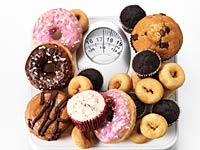How To Deal With Your Cravings
1. Take a close look at your diet.
Inconsistencies in your diet can set you up for cravings. For example, if you skip breakfast and lunch, with no snacks, you're looking at a pretty ravenous appetite come mid-afternoon. Then there's dinner - you could overeat. Some people binge and consume thousands of calories.
The solution - Balance your meals and snacks throughout the day to control blood sugar levels and keep your energy up.
2. What do you REALLY want?
Sometimes what you crave is found in PART of a meal. In other words, do you need to eat the WHOLE meal, or is there just ONE thing that will satisfy the craving, like salt, or bread?
3. Don’t rush in.
We are an instant gratification society. "If my craving doesn't go away NOW, forget it. I'm going to have those dozen Dunkin Donuts." Just wait 15 minutes or so before you cave in. In the meantime, drink a 16-ounce glass of cold water to help fill you up. The desire often passes.
4. Find a healthier substitute.
Identify the healthiest substitute that will hit the spot. If you're having a sweet tooth, your craving might be satisfied by grabbing a banana or a handful of grapes (with less calories and more nutritious).
5. If nothing works, go for it.
If your craving is undeniable, just do it. Many times people, in an effort to avoid the thing they're craving, will overeat everything BUT the food they were craving. Then a little later they end up having the food they craved in the first place. It's a triple-whammy: guilt for stuffing your face, guilt for coming back and having the thing you craved in the first place, then feeling really gross for overeating.
6. Don't be too strict with yourself.
Two ways you can do this. First, before you satisfy a craving, set yourself up for a positive outcome. Give yourself permission, keep the portion moderate, and accept that you're satisfying the craving. Second, if you realize you have satisfied a craving without thinking, then just accept it, period. It happened.
Move on! How are you going to do better next time? The point is, if you keep harping on yourself for being such a "bad" person for succumbing to your craving, you're going to keep eating that way. By accepting and moving on, you're not giving yourself a chance to retreat to old habits.
7. Catch yourself before you get out of hand.
A few ways to do this one:
Store food in Ziploc sandwich bags. When you're ready to eat, that's all you get.
Only one helping - put the amount of food you'll eat on your plate (be reasonable), then leave the rest for everybody else, or store in fridge/freezer, or use the Ziploc idea.
Ban too-tempting foods from your home altogether.
8. Have a routine. It's really easy to stand in front of the pantry and gobble a package of cookies. Take a couple, eat slowly, and savor each bite. (Have some water with it, too.) You'll eat less and enjoy the treat more.
9. Sweat.
Regular exercisers report far fewer food cravings than their sedentary counterparts. Part of has to do with the feel-good endorphins released during physical activity. Plus, regular exercisers tend to feel more in control of their bodies, so they're less likely to binge. Think about it: if you're exercising every day, feeling good about yourself with high energy, you wouldn't want to waste that on eating junk all the time, would you?
10. Keep a journal.
In your food journal, keep notes on how often, why, and when you crave certain foods. When you understand what triggers your cravings - boredom, stress, fatigue, etc. - you can manage them better.
Related Articles
-
Diet Tips Pregnancy
The history of diet plan dated from the moment that the first monkey e
-
Exercise Routine To Flatten Stomach
When you are already bothered by the presence of unwanted fat in yo
-
Learn How to Lose Weight Using the Oprah Approved Acai Diet
You can Lose Weight Using the Oprah Approved Acai Diet Plan. People ar
-
Fat Burning Workouts - Circuit Training
Are you still stuck on the marathon aerobics workout nonsense? Imagine
-
Get Rid Of Fat Stomach in 2 Weeks - Finally, a Proven Diet to Easily Lose Belly Fat Fast & Naturally!
Have you done almost everything and anything under the sun to get rid
-
How To Get 6 Pack Abs Quick
How to get 6 pack abs quick ? The Truth About Abs is the number one se
- DON'T MISS
- Setting Diet Goals
- Foods That Burn Belly Fat
- 10 Ways To Eat Like A Mediterranean
- Which Anti Cellulite Products Work for Reducing or Getting Rid of Cellulite?
- The Weight loss plan Program Review
- Exercises To Burn Stomach Fat
- Orlistat used to kick noto loosing alot of extra weight - pillsformedicine
- Fast Weight Loss And the Nutritional Plan That Makes it Happen For Fat Loss
- Checkout weight loss online calculators for getting appropriate BMR
- Rapid Safe Weight Loss - Is It Really Possible?




